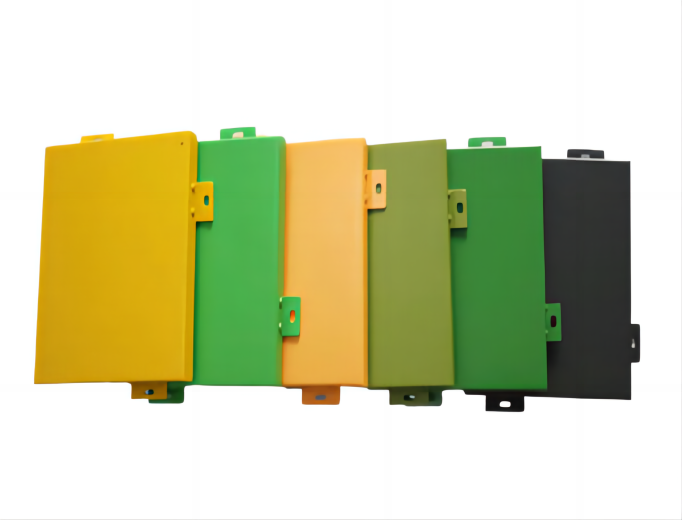technological innovation
What are the differences between fluorocarbon spraying and powder coating for aluminum veneer curtain walls?
Strolling through the bustling city, the ubiquitous aluminum veneer curtain walls add boundless vitality to the urban landscape. The city's architecture adorned with aluminum veneer reveals the beauty of the city, showcasing the allure of aluminum veneer products! Apart from the inherent metallic characteristics, aluminum veneer benefits from its surface coating process. This article will introduce the differences between aluminum veneer fluorocarbon spraying and powder coating.

1.Different Coatings
Fluorocarbon spraying is an electrostatic spraying process and a form of liquid coating. Fluorocarbon paint is a type of coating that primarily uses fluororesin as the main film-forming material. Currently, there are three main types of fluorocarbon coatings widely used in the market: PVDF, FEVE, and PTFE, all of which are solvent-based liquid coatings. Fluorocarbon spraying offers excellent corrosion resistance and weather resistance, able to withstand acid rain, salt spray, various air pollutants, and extreme temperature changes. It can resist strong UV radiation, maintain colorfastness and integrity over a long time, and has a long service life.
Powder coating uses powder coatings and employs an electrostatic spraying process. Powder coatings are a type of solvent-free solid powder coating with characteristics such as solvent-free, pollution-free, energy-saving, resource-efficient, reduced labor intensity, and high coating mechanical strength. Common powder coatings include architectural powder coatings, thermoplastic powder coatings (PE), and thermosetting powder coatings. In the aluminum veneer industry, powder coating is rapidly adopted due to its advantages of simple process, pollution-free, minimal waste, excellent coating effect, and strong corrosion resistance.
2.Spraying Techniques
The process for fluorocarbon spraying of aluminum veneers is as follows:
Pre-treatment process: Aluminum veneers are degreased → washed with water → alkali washed (degreased) → rinsed with water → acid washed → rinsed with water → chromated → rinsed with water → rinsed with pure water.
Fluorocarbon spraying process: Primer spraying → topcoat spraying → clearcoat spraying → baking (180-250°C) → quality inspection.
Fluorocarbon multi-layer spraying processes can be divided into two-coat, three-coat, and four-coat methods. Two-coat consists of primer and topcoat, three-coat adds a clearcoat (protective coat), and four-coat includes primer, isolating coat, topcoat, and clearcoat (protective coat). Generally, two-coat and three-coat processes are widely used in the market.
The process for powder coating of aluminum veneers is as follows:
Pre-treatment of aluminum veneers → powder spraying → baking and curing → quality inspection → finished product.
Powder coating surface coating process consists of one coating and one baking step.
3.Baking Temperatures
Fluorocarbon spraying baking temperature for aluminum veneers: 230°C.
Powder coating baking temperature for aluminum veneers: indoor powder 180°C, outdoor powder 200°C.
4.Functional Characteristics
Weather resistance (UV resistance, color retention, gloss preservation, wind and sun resistance):
Fluorocarbon-sprayed aluminum veneers have a service life of more than 15 years, while powder-coated aluminum veneers have a service life of over 5 years for indoor use and over 10 years for outdoor use.
Fluorocarbon spraying film thickness: between 30-60μm.
Powder coating film thickness: between 40-120μm.
Fluorocarbon-sprayed aluminum veneers commonly have colors like white, red, blue, green, silver, gold, etc., with a generally moderate glossiness.
Powder-coated aluminum veneers commonly have colors like gray, white, black, metallic, and more, and can also be glossy, matte, or non-glossy.
Due to the versatility of powder coatings, they offer more options in appearance, allowing for a wide range of colors and finishes, including artistic coatings and adjustable gloss levels. Fluorocarbon coatings have certain limitations in appearance selection, with lower gloss levels and no adjustability.
5.Price Difference
Due to the coating differences, powder coatings are generally much cheaper than fluorocarbon paints, but both use electrostatic spraying technology. Depending on specific requirements, there are alternative methods for fluorocarbon spraying, such as fluidized bed and friction gun spraying.
RELATED NEWS
- Not sure about the T4, T5, and T6 materials of aluminum profiles? This article h 2024-03-20
- How to use aluminum profile section design skills to solve extrusion production 2024-03-19
- Factors affecting the life of trimming and punching molds 2024-03-12
- Overview of Steel/Aluminum Welding Technology 2024-02-29
- Steel belt conveying direction 2023-09-26
CATEGORIES
LATEST NEWS
CONTACT US
Contact: Manager:Miss Jasmien
Phone: +8618825429836
E-mail: info@gdaa-cn.com
Whatsapp:+8618825429836
Add: Headquarter:No.8,Yixian Road,GDAA Mansion,Guangfo Zhicheng, Dali Town,Foshan,Guangdong.China
